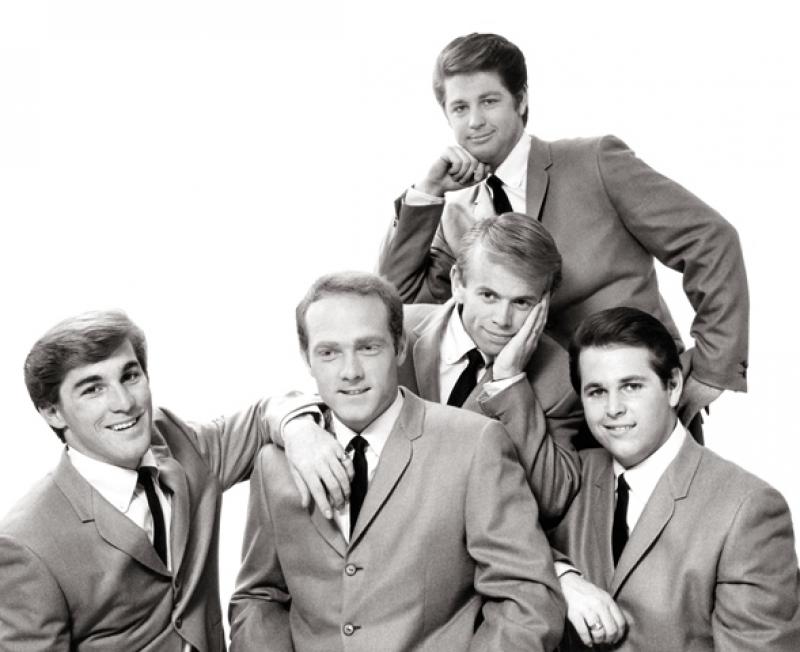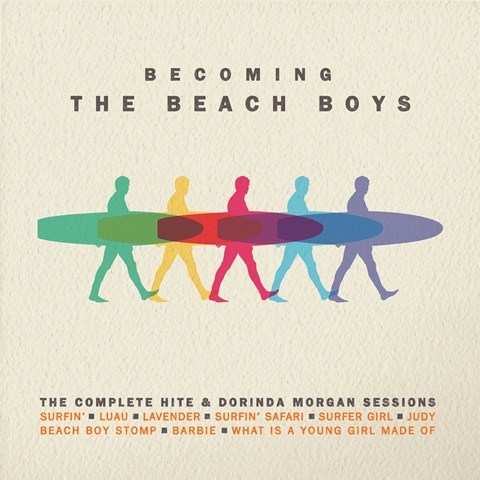Reissue CDs Weekly: The Beach Boys | reviews, news & interviews
Reissue CDs Weekly: The Beach Boys
Reissue CDs Weekly: The Beach Boys
Fan-only only package of Brian Wilson and co’s complete pre-Capitol tapes

The Beach Boys signed with Capitol Records on 24 May 1962. Early the next month, their first single for the label became “409”/”Surfin’ Safari”. It was not their debut release. The “Surfin'”/ “Luau” single had been issued in November 1961 by Candix.
Before Capitol, Hite and Dorinda Morgan had brought them into a recording studio. The former was a music publisher known by Murry Wilson, the father of Beach Boys’ Brian, Carl and Dennis. When the Morgans first encountered the band, they were known as The Pendeltones. Without being asked, they were renamed The Beach Boys for the release of "Surfin'”. Their next single, “Barbie”/“What is a Young Girl Made of” was credited to Kenny and the Cadets. For this, the Morgans had the band track their vocals over pre-recorded instrumental tracks. The identity crisis ceased once they were with Capitol.
 Becoming the Beach Boys: The Complete Hite & Dorinda Morgan Sessions collects everything from the surviving tapes recorded before the Capitol signing. Across two discs, the 62 tracks include a demo, eight takes and the master of “Surfin’”. For “Luau”, there is a demo, 18 takes and the master. Similarly in-depth sequences are devoted to “Barbie”, “Beach Boy Stomp”, "Judy", “Lavender”, “Surfer Girl”, “Surfin’ Safari” and “What is a Young Girl Made of”.
Becoming the Beach Boys: The Complete Hite & Dorinda Morgan Sessions collects everything from the surviving tapes recorded before the Capitol signing. Across two discs, the 62 tracks include a demo, eight takes and the master of “Surfin’”. For “Luau”, there is a demo, 18 takes and the master. Similarly in-depth sequences are devoted to “Barbie”, “Beach Boy Stomp”, "Judy", “Lavender”, “Surfer Girl”, “Surfin’ Safari” and “What is a Young Girl Made of”.
At the Morgan’s home in September 1961, they had recorded a demo of “Surfin’”, a demo and three takes of “Luau”, a rehearsal and a take of “Lavender”. All three songs were next taped at either World Pacific or Stereo Masters in October or November 1961. “Surfin’ Safari”, “Surfer Girl”, “Judy”, and “Beach Boy Stomp” (aka “Karate”) were then recorded at World Pacific Studio on 8 February 1962. The vocals of “Barbie” and “What is a Young Girl Made of” were taped at Stereo Masters on 8 March 1962. These sessions comprise what's heard on Becoming the Beach Boys.
The Beach Boys’ subsequent success and fame ensured that some of what had initally been unheard did not stay on the shelf. The scrappy and cheekily titled 1969 album Beach Boys Biggest Hits (pictured below left) was the first release to exploit these tapes (two of its tracks weren't by The Beach Boys). The 1991 Lost and Found (1961–1962) CD sampled the tapes more extensively and was the first time they were issued with annotation and proper packaging. The arrival of Becoming the Beach Boys with its wholesale approach renders the 1991 release (and reissues of it) redundant.
 While historically important, the aural baby pictures on Becoming the Beach Boys will be a slog for anyone who is not a full-on fan. The studio chat is fun, but successive runs through “Judy” are taxing and ultimately irritating. Even though it is an early Brian Wilson composition, hearing the trite song repeatedly is an endurance test. It's slight, written by a neophyte songwriter and the performers are a just-formed band. This is not the eternally fascinating Beach Boys of “Good Vibrations” or even “Fun Fun Fun”, but an embryonic band groping their way towards finding out who they were. When perfection is reached, the preceding repetition has rendered appreciation of the final master of "Judy" impossible.
While historically important, the aural baby pictures on Becoming the Beach Boys will be a slog for anyone who is not a full-on fan. The studio chat is fun, but successive runs through “Judy” are taxing and ultimately irritating. Even though it is an early Brian Wilson composition, hearing the trite song repeatedly is an endurance test. It's slight, written by a neophyte songwriter and the performers are a just-formed band. This is not the eternally fascinating Beach Boys of “Good Vibrations” or even “Fun Fun Fun”, but an embryonic band groping their way towards finding out who they were. When perfection is reached, the preceding repetition has rendered appreciation of the final master of "Judy" impossible.
This nascent Beach Boys were steered by their sponsors. They did what they were told to do. “Luau”, the icky “Lavender”, the doll-craze cash-in “Barbie” and “What is a Young Girl Made of” were not band compositions but by the Morgans, so are musical entries in the margins of The Beach Boys' story. Their significance lies solely in being early recordings by what would become one of the world’s best bands.
Where Becoming the Beach Boys fascinates is in tracking the band and Brian Wilson’s swift path towards finding their own voice. Disc One, Track One is a skeletal demo of “Surfin’” which suggests the band were already vocally proficient and engaging when they were on the starting block. But, unsurprisingly, it is wobbly. Disc Two begins with Take One of “Surfer Girl”. Despite the shaky vocal meshing, the band is taking shape. Smoothness and confidence are emerging. By Take Seven, the master, the track really sounds like a radio-friendly hit single in waiting. Even so, listening to Becoming the Beach Boys as if it were a traditional album is impossible. The only ears which will get something from it are those already deeply familiar with The Beach Boys’ earliest days. This is no casual purchase.
Share this article
The future of Arts Journalism
You can stop theartsdesk.com closing!
We urgently need financing to survive. Our fundraising drive has thus far raised £49,000 but we need to reach £100,000 or we will be forced to close. Please contribute here: https://gofund.me/c3f6033d
And if you can forward this information to anyone who might assist, we’d be grateful.

Subscribe to theartsdesk.com
Thank you for continuing to read our work on theartsdesk.com. For unlimited access to every article in its entirety, including our archive of more than 15,000 pieces, we're asking for £5 per month or £40 per year. We feel it's a very good deal, and hope you do too.
To take a subscription now simply click here.
And if you're looking for that extra gift for a friend or family member, why not treat them to a theartsdesk.com gift subscription?
more New music
 Album: Mulatu Astatke - Mulatu Plays Mulatu
An album full of life, coinciding with a 'farewell tour'
Album: Mulatu Astatke - Mulatu Plays Mulatu
An album full of life, coinciding with a 'farewell tour'
 Music Reissues Weekly: Sly and the Family Stone - The First Family: Live At Winchester Cathedral 1967
Must-have, first-ever release of the earliest document of the legendary soul outfit
Music Reissues Weekly: Sly and the Family Stone - The First Family: Live At Winchester Cathedral 1967
Must-have, first-ever release of the earliest document of the legendary soul outfit
 Album: Robert Plant - Saving Grace
Mellow delight from former Zep lead
Album: Robert Plant - Saving Grace
Mellow delight from former Zep lead
 Brìghde Chaimbeul, Round Chapel review - enchantment in East London
Inscrutable purveyor of experimental Celtic music summons creepiness and intensity
Brìghde Chaimbeul, Round Chapel review - enchantment in East London
Inscrutable purveyor of experimental Celtic music summons creepiness and intensity
 Album: NewDad - Altar
The hard-gigging trio yearns for old Ireland – and blasts music biz exploitation
Album: NewDad - Altar
The hard-gigging trio yearns for old Ireland – and blasts music biz exploitation
 First Person: Musician ALA.NI on how thoughts of empire and reparation influenced a song
She usually sings about affairs of the heart - 'TIEF' is different, explains the star
First Person: Musician ALA.NI on how thoughts of empire and reparation influenced a song
She usually sings about affairs of the heart - 'TIEF' is different, explains the star
 Album: The Divine Comedy - Rainy Sunday Afternoon
Neil Hannon takes stock, and the result will certainly keep his existing crowd happy
Album: The Divine Comedy - Rainy Sunday Afternoon
Neil Hannon takes stock, and the result will certainly keep his existing crowd happy
 Music Reissues Weekly: Robyn - Robyn 20th-Anniversary Edition
Landmark Swedish pop album hits shops one more time
Music Reissues Weekly: Robyn - Robyn 20th-Anniversary Edition
Landmark Swedish pop album hits shops one more time
 Album: Twenty One Pilots - Breach
Ohio mainstream superstar duo wrap up their 10 year narrative
Album: Twenty One Pilots - Breach
Ohio mainstream superstar duo wrap up their 10 year narrative
 Album: Ed Sheeran - Play
A mound of ear displeasure to add to the global superstar's already gigantic stockpile
Album: Ed Sheeran - Play
A mound of ear displeasure to add to the global superstar's already gigantic stockpile
 Album: Motion City Soundtrack - The Same Old Wasted Wonderful World
A solid return for the emo veterans
Album: Motion City Soundtrack - The Same Old Wasted Wonderful World
A solid return for the emo veterans
 Album: Baxter Dury - Allbarone
The don diversifies into disco
Album: Baxter Dury - Allbarone
The don diversifies into disco

Add comment